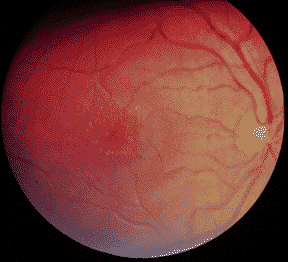
Do you have advice for us?
Have you found a useful bit of advice that we've neglected to mention? Please let us know at <molvis@emory.edu>.
Reprinting Articles
Molecular Vision articles are formatted in HTML and PDF. HTML formatting is quick to load from the web and your web browser can understand it directly. Unfortunately, HTML formatted documents are sometimes difficult to print. The Portable Document Format (PDF) allows articles to be formatted for print, greatly simplifying the process of printing an article. To take advantage of the PDF files, readers will need to get either the PDF reader or the PDF plug-in from Adobe. (There is also advice below if you are going to print with a Black & White printer.)
You can get the Adobe Acrobat Reader by clicking on the icon below. Adobe offers this program for various versions of Mac/OS, Windows, OS/2, Unix, and Linux. Specific configuration instructions are provided at the Adobe site.
If you have problems with the degree symbol (°) or the Greek letter mu (μ) not appearing correctly in Acrobat Reader 6, we recommend switching to Acrobat Reader 4, 5, or 7, Preview.app (Mac OS X), or Xpdf (Unix, VMS, OS/2). This is a known issue with some versions of Acrobat Reader 6 and may affect some other symbols.
If you have problems viewing the reprint in your browser, we recommend that you download the file to your computer. Depending on your operating system, this can be done by "right clicking," "control clicking," or "clicking and holding" the link to the PDF file. Once the PDF file is on your computer, it can be viewed with Acrobat Reader.
At this time, the Molecular Vision editors recommend using Acrobat Reader without the browser plug-in. Either will allow you to configure your browser to display and print PDF files, but the plug-in usually requires more time to print a document.
The best results with Black & White printers
When printing color images to a black & white printer, look for a print option to "Print in Grayscale" rather than "Print in Black & White" in the "Print" dialog box.
Viewing movies and animations
If movies or animations are not displaying properly, make sure you have the current version of Quicktime and the Quicktime plug-in. It is available at no charge from Apple Computer for Mac/OS and Windows. Also, if you have changed or upgraded your browser since you installed Quicktime, you may need to make sure that your browser is using the correct Quicktime plug-in.
Upgrade to the newest version of your browser
Molecular Vision is designed to be friendly to the greatest number of browsers, but we've found that the newer versions of some browsers have been more stable, if you have the memory (RAM) they require. Mozilla, Netscape, and Internet Explorer are free.
Colors that do not look right
If the colors displayed on your monitor do not look right, try quitting (or exiting) from any imaging software (programs to view or edit images) in use. Imaging software (e. g., PhotoShop, Illustrator) can sometimes "take over" your computer's color map. Quitting these programs will generally resolve this problem.
The meaning of "pagination pending"
Molecular Vision's primary format is HTML. After an article is published, a PDF (Portable Document Format) version is prepared for reprints (see Reprinting Articles). Page numbers for Molecular Vision articles are allocated based on the length of the PDF version. Hence, the page numbers for an article are not known until its PDF version is complete. There can sometimes be a lag of a few days between publication and when page numbers are available. During this period, "[pagination pending]" appears where page numbers are normally listed in an article.
Use 256 (or more) colors
 |
 |
|
|
|
The figure on the left is a copy of the figure on the right that has been reduced to 16 colors to simulate how images appear when your monitor is set to 16 colors (4 bit color depth). If the images appear identical to you, your monitor is set to 16 colors or less. This setting was often the default under versions of Windows prior to Windows 95. If you use a version of Windows prior to Windows 95, it is very difficult to recover from errors made while changing this setting (the number of colors). Read your computer's documentation very carefully before attempting to change this setting. With a greater number of colors on your monitor, you should notice that the image on the right is less posterized (has fewer "bands"), has less dithering, and appears less grainy. (Image from Figure 1A of Mol Vis 1997; 3:1.)